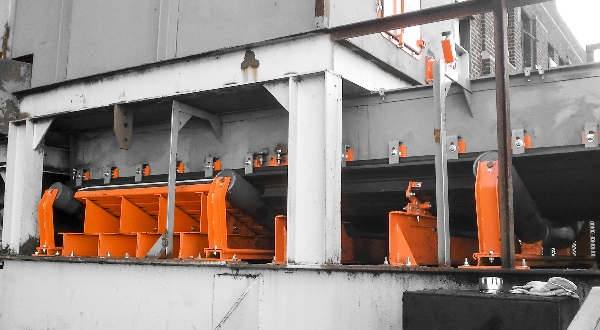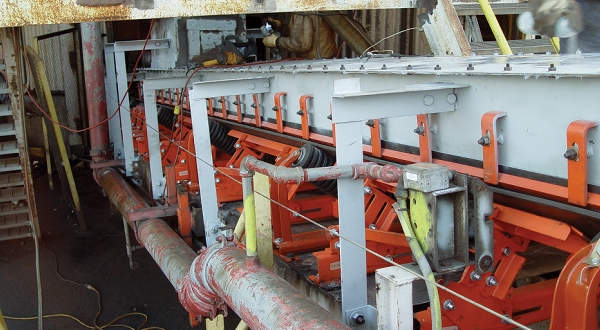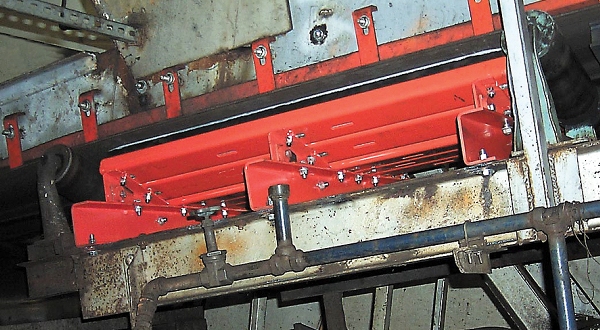
Martin® Impact Cradles contribute to longer lasting conveyor belts
and components, with less fugitive material and a safer work area.
[Neponset, IL] – A global innovator in bulk handling technology offers a family of impact cradles engineered to prevent belt and mainframe damage and eliminate spillage of heavy materials. The Martin® Impact Cradles Heavy Duty (HD), Medium Duty (MD) and Light Duty (LD) feature a bed of steel angles lined by energy-absorbing impact bars with a top layer of low friction, ultra-high molecular weight (UHMW) plastic. The result is longer lasting conveyor belts and components, with less fugitive material and a safer work area.
“Fine material discharged from a height can have just as much force as a coarse load,” explained Product Engineer Daniel Marshall. “Without proper impact absorption and distribution, all of that force is exerted on the belt, essentially crushing it against a rigid surface underneath. The impact beds absorb the energy, so the belt doesn’t have to. It also creates a flat edge for the apron seal, to prevent spillage and fugitive dust.”
The Martin Engineering cradles are designed to be located at transfer points of receiving conveyors, under the hopper and chute box, close to the tail pulley. Depending on the force of the discharged material, they can possess different structural qualities. All three Martin Impact Cradles feature wing supports, which adjust to match CEMA standard trough angles, as well as a 5 percent fine-tuning adjustment angle. This allows for the cradle to accommodate the idler profiles of different manufacturers and assure a tight belt seal.

The cradles are designed to be located at transfer points of receiving
conveyors, under the hopper and chute box, close to the tail pulley.
The Martin® Impact Cradle HD is the company’s most rugged design, able to withstand impact forces from 12,000 to 17,000 lbf. (53.4 to 75.6 kN) and drop heights of light material up to 50 ft (15.2 m). Classified as Heavy-Duty (H) in CEMA Standard 575-2000, it fits E-6 and E-7 conveyor configurations. Support beams in the center of the cradle are set 3/4″ (19 mm) below the receiving belt’s line of travel, allowing the belt to avoid sustained friction when running empty, yet absorbing significant impacts during loading while still retaining a tight seal.
“The HD Cradle is designed to handle a load equal to a full-sized refrigerator being dropped from a height of ten feet,” said Marshall.
The unit is equipped with 7-13 heavy-duty impact bars, depending on width. Installed perpendicular to the belt path, the bars are reinforced by a steel support structure with a base of impact-absorbing 50-durometer styrene-butadiene (SBR) rubber and a top layer of slick UHMW plastic. They are engineered to withstand dynamic energy and a heat range of -20° to 140°F (-29° to 60°C) without compromising the structural integrity of the conveyor frame. The cradle is on a Trac-Mount™, allowing it to slide out for easy bar replacement.
The Martin® Impact Cradle MD is designed for medium duty applications, suitable for use with belts traveling up to 1,000 ft/min (5 m/s). Mounted on four rugged steel I-beam supports, the cradle is able to sustain a maximum weight of 12,000 ft/lbs (53.4 kN) with light material drop heights up to 26 ft. (7.9 m). Classified as Medium-Duty (M) in CEMA Standard 575-2000, the unit is available for belt widths from 24″ to 72″ (500 to 1,828 mm).
Depending on width, the MD Cradle is fitted with 6 to 16 durable impact bars. They are composed of an aluminum T-slot surrounded by energy absorbing 83A-durometer urethane, coated with a layer of low-friction UHMW plastic, which prevents belt fraying while retaining a tight seal at operating temperatures of -20° to 180°F (-29° to 82°C). Each bar is reinforced by a bed of steel “wing” supports, which can be adjusted to match any CEMA standard trough angle, with five degrees of wear adjustment.
“The MD model can withstand a weight of 90 pounds (40.8 kilos) dropped from a 10-foot height,” Marshall added. “That’s roughly equivalent to a bag of ready-mix concrete, or around 12,000 ft/lbs.”
Like the MD, the Martin® Impact Cradle LD conforms to CEMA No. 502-1998 & 575-2000, but the Class L design is made for lighter materials with impact forces that could still affect the belt and conveyor over time. Utilizing the same impact bar technology, it is able to withstand a maximum weight of 8,500 ft/lbs (37.8 kN), equal to 50 pounds (22.7 k) being dropped from ten feet, with light material drop heights of up to 12 ft. (3.6 m).
Mounted on three steel channel beams, the LD is available for belts from 24 to 48 inches (610 to 1219 mm) wide, with 6-10 impact bars. The unit controls the spillage of dust and fines at belt speeds as high as 1,000 ft/min (5 m/s).
“Almost all bulk material, no matter the settled weight, has some form of impact on receiving belts at transfer points,” Marshall concluded. “Left uncontrolled, the constant force and spillage on the belt can bring about gouging and fraying, which can cause misalignment that leads to expensive system damage and a potential workplace hazard.”

The cradles feature a bed of steel angles lined by energy-absorbing
bars with a top layer of ultra-high molecular weight (UHMW) plastic.
Founded in 1944, Martin Engineering is the world leader in making bulk materials handling cleaner, safer and more productive. The company supplies flow aids and conveyor products around the world for a wide variety of bulk material applications, including coal, cement / clinker, rock / aggregate, biomass, grain, pharmaceuticals, food and other materials. The firm is headquartered in Neponset, IL, offering manufacturing, sales and service from factory-owned business units in Brazil, China, France, Germany, Indonesia, Mexico, South Africa, Turkey, India and the UK, and under exclusive license with ESS Australia. For more information, visit www.martin-eng.com or call (309) 852-2384. Global representatives for Martin Engineering can be found at www.martin-eng.com/rep-finder.